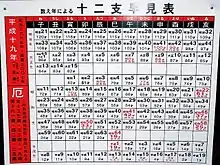Yakudoshi
Yakudoshi (厄年), or "calamitous years," are ages that in Japan are traditionally believed to be unlucky.

Unlucky Years
The ages most often considered unlucky in Japan are 25, 42, and 61 for men, and 19, 33, and 37 for women, though there is much regional variation. Note that yakudoshi are calculated by traditional age reckoning in Japan, according to which children are considered to be one year old at birth, and add to their age every New Year's Day.[1]:108 [2]:197 In some communities, the sixty-first year, which was traditionally the year for retirement, has been held to be lucky rather than unlucky.[1]:113 Among the unlucky years, the most unlucky are thought to be the ages of 42 for men and 33 for women, which are known as daiyakudoshi, or "great-calamity years."[1]:108 The year preceding a yakudoshi year, called a maeyaku (前厄) year, is also considered dangerous, as is the year following one, called atoyaku.[1]:111 [2]:198
Although yakudoshi is a folk belief, it is shared even by many sophisticated urban Japanese, though the anthropologist David C. Lewis noted in a 1998 study that "Even if a person does visit a shrine or buy a charm on account of social pressures, some inner scepticism about the 'truth' of the yakudoshi beliefs might remain."[2]:201-205 The superstition is taken very seriously, for example, by the high-status family at the heart of Tanizaki's novel The Makioka Sisters.[1]:106
Different historical sources specify different ages as yakudoshi. For example, the Iroha Jiruishō (色葉字類抄), a Japanese dictionary from the Heian period (12th century), states that the years 13, 25, 37, 49, 61, 73, 85, 97 are unlucky.[3] On the other hand, the Shuugaishou (拾芥抄), from the Kamakura period, states that 13, 25, 37, 49, 61, 73, and 99 are yakudoshi.[4] The 16th-century source Kanei (寛永) states that 13, 25, 37, 49, 61, 85, and 99 are the yakudoshi numbers.[5] And in Buddhist teachings, meanwhile, 7, 13, 33, 37, 42, 49, 52, 61, 73, 85, 97, and 105 are considered to be unlucky.[3]
Remedies
To ward off the misfortunes believed to occur during a yakudoshi, individuals may engage in prayer to Shinto or Buddhist deities, attend rituals, purchase protective charms, make pilgrimages, exchange gifts, or hold special festivities, usually at the beginning or end of the year. [1]:109 [2]:197 [6] An anthropologist reported in 1955 that to send away the danger associated with a yakudoshi, individuals sometimes abandoned a personal item such as a comb or a writing brush at a crossroads,[1]:110 and that in one region, men wore underwear in the lucky color of red during their forty-second year.[1]:111
A yakudoshi festival is held annually at Hachiman shrines on January 18 and 19. During the two-day period, people entering either a maeyaku or yakudoshi year attend the shrine to undergo a harae ritual called yakubarai (厄払い). The ceremony involves a priest reciting a prayer whilst waving a haraegushi above the person in order to ward off the unlucky spirits. People also purchase items to display in their home or carry on their person to protect them during the year.[7]
Origins
Some elements of yakudoshi beliefs probably stem from the Chinese-derived astrological system known as Onmyōdō, though yakudoshi practice today is more closely associated with Shinto institutions.[2]:196 Several scholars find it suggestive, for example, that the Chinese lunar-solar calendar runs on a sixty-year cycle, so that in one's unlucky sixty-first year, one is at the same point in the cycle as in the year of one's birth.[1]:108 [2]:198 The yakudoshi superstitions may also be related to indigenous traditional Japanese beliefs regarding ritual purification and affinity by age. In some rural communities, it was thought necessary to avoid exchange yakudoshi gifts with, or attending the yakudoshi festivities of, one's age-mates during an unlucky year.[1]:114
Many Japanese believe that the bad luck associated with some ages derives from puns that it is possible to make with their numerals. The numeral 33, for example, can be pronounced sanzan, which may mean either "troublesome" or "birth difficulty," the numeral 42 can be pronounced shi ni, meaning "to death," and the number 19 can be pronounced jū ku, meaning "intense suffering." In 1955, the anthropologist Edward Norbeck dismissed such explanations as "folk etymology," arguing that when yakudoshi practices first arose, literacy was not widespread enough for homonyms to have caused them, but in 1998, another scholar, David C. Lewis, suggested that such puns involve only simple Chinese characters for numbers and could indeed have been widely known even in early periods. [1]:118 [2]:198 [8]
When asked about yakudoshi, Japanese sometimes say that they mark the boundaries of significant life-stages or that they mark significant moments of change in the human body.[2]:200
External links
References
- Norbeck, Edward (1955). "Yakudoshi, a Japanese Complex of Supernaturalistic Beliefs". Southwestern Journal of Anthropology. 11 (2): 105–20. JSTOR 3628964.
- Lewis, David (1998), "'Years of Calamity': Yakudoshi observances in urban Japan", in Hendry, Joy (ed.), Interpreting Japanese Society: Anthropological Approaches, Routledge, pp. 196–212
- Tachibana, Tadakane, ed. (1177–1188). Iroha Jiruishō. 2. p. 43.
- [洞院公賢] 清原枝賢等筆永正七年1510写. 京都大学附属図書館. 2011年2月9日閲覧
- [洞院公賢] 寛永壬午孟夏吉旦西村氏吉兵衛新刊. 京都大学附属図書館. 2011年2月9日閲覧
- Chavez, Amy (2011-01-15). "Facing your unlucky years". The Japan Times. Retrieved 2013-03-31.
- Source?
- "Yakudoshi: The year of calamity | Essays in Idleness". Jkllr.net. 2009-02-22. Retrieved 2013-03-31.